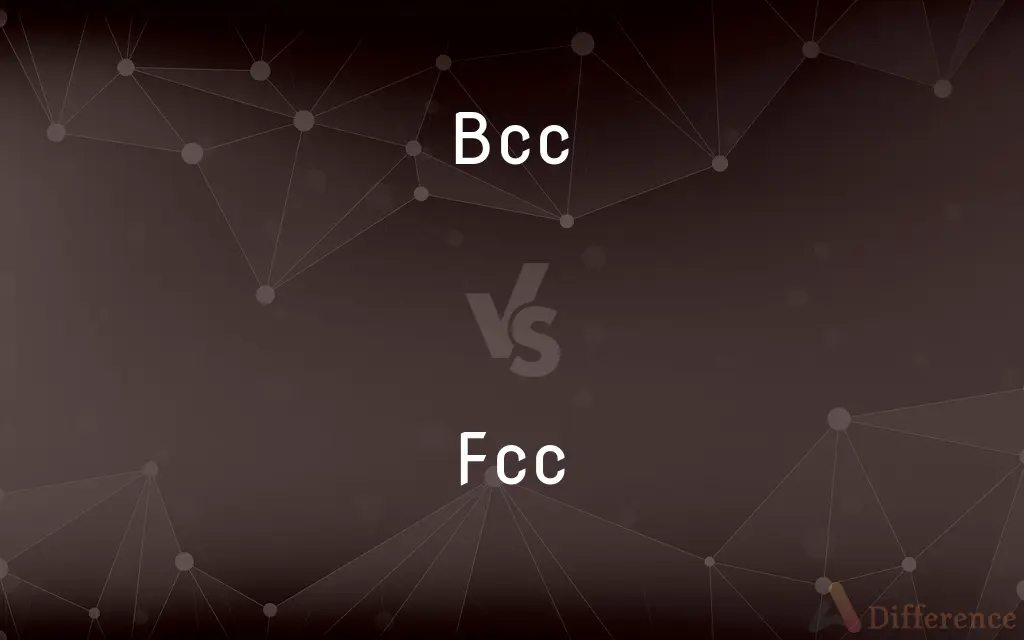BCC vs. FCC — What's the Difference?
By Maham Liaqat & Fiza Rafique — Updated on March 13, 2024
BCC (Body-Centered Cubic) packs atoms with a cube having an atom at its center, while FCC (Face-Centered Cubic) has atoms at each cube's corner and the center of its faces.

Difference Between BCC and FCC
Table of Contents
ADVERTISEMENT
Key Differences
BCC (Body-Centered Cubic) structure is where atoms are positioned at each corner of a cube with one atom at the center, maximizing space in a different manner than FCC. In FCC (Face-Centered Cubic), atoms are located at each corner of the cube and the centers of all the cube faces, leading to a denser packing.
BCC's arrangement allows for less dense packing with atoms, as there are fewer atoms per unit cell compared to FCC. This results in BCC structures being less closely packed and having a lower atomic packing factor. On the other hand, FCC structures have atoms at each face center in addition to the corners, creating a more densely packed arrangement with a higher atomic packing factor.
The slip systems, or the planes along which atoms most easily slide over each other, differ between BCC and FCC due to their distinct lattice structures. BCC metals typically have fewer and more complex slip systems, making them less ductile. In contrast, FCC metals, with their closer packing and greater number of slip systems, tend to be more ductile.
BCC metals generally have a lower coordination number, which is the number of nearest-neighbor atoms, compared to FCC metals. This influences the mechanical properties, such as strength and ductility. FCC metals, with their higher coordination number, often exhibit higher strength and ductility.
The difference in lattice structure also leads to variations in the density of dislocations, which are line defects in the crystal structure. BCC structures, with their less dense packing, can accommodate fewer dislocations, whereas FCC structures, being more closely packed, can accommodate more, affecting their mechanical and thermal properties.
ADVERTISEMENT
Comparison Chart
Atom Positioning
Atoms at each cube corner and one at the center
Atoms at each cube corner and the centers of all the faces
Packing Density
Less dense, fewer atoms per unit cell
More dense, more atoms per unit cell
Atomic Packing Factor
Lower due to less dense packing
Higher due to more dense packing
Slip Systems
Fewer and more complex, leading to less ductility
More numerous and simpler, leading to greater ductility
Coordination Number
Lower, affecting mechanical properties like strength
Higher, often resulting in greater strength and ductility
Compare with Definitions
Bcc
BCC stands for Body-Centered Cubic, a crystal structure in which atoms are positioned at each corner of a cube and one atom at the center.
Iron at room temperature forms a BCC structure, contributing to its magnetic properties.
Fcc
FCC stands for Face-Centered Cubic, a type of crystal structure where each cube's face has an atom at its center, in addition to the corners.
Aluminum exhibits an FCC structure, making it highly ductile and suitable for forming processes.
Bcc
The BCC arrangement allows for a unique distribution of atoms, affecting the material's slip systems and ductility.
Molybdenum, with its BCC structure, exhibits high strength at high temperatures.
Fcc
FCC metals are known for their great ductility due to their many slip systems.
Gold's FCC structure makes it extremely malleable, ideal for jewelry making.
Bcc
In BCC structures, the atoms are less closely packed compared to other crystal structures, resulting in specific physical properties.
Chromium has a BCC structure, making it less ductile but good for hardening steel.
Fcc
The higher coordination number in FCC structures influences their strength and ductility.
Nickel's FCC structure provides it with good corrosion resistance and mechanical properties.
Bcc
BCC metals typically have a lower atomic packing factor, influencing their density and mechanical properties.
Tungsten's BCC structure contributes to its high melting point and density.
Fcc
The dense packing in FCC structures accommodates a high density of dislocations, affecting deformation.
The FCC structure of Silver is key to its thermal and electrical conductivity.
Bcc
The central atom in a BCC structure plays a significant role in determining the crystal's physical characteristics.
The BCC structure of Vanadium is crucial for its use in aerospace alloys.
Fcc
The FCC structure is characterized by a high atomic packing factor, leading to dense atomic arrangements.
Copper's FCC structure contributes to its excellent electrical conductivity.
Bcc
Initialism of blind carbon copy
Fcc
(crystallography) face-centered cubic
Bcc
Initialism of body-centered cubic
Fcc
An independent governmeent agency that regulates interstate and international communications by radio and television and wire and cable and satellite
Bcc
To send something by blind carbon copy.
Common Curiosities
What defines a BCC structure?
A BCC structure is defined by atoms located at each corner of a cube with an additional atom at the center.
What impact does the coordination number have on BCC and FCC?
A lower coordination number in BCC leads to different mechanical properties than FCC, which has a higher number, affecting strength and ductility.
How does the slip system differ between BCC and FCC?
BCC has fewer and more complex slip systems, making it less ductile, whereas FCC has more and simpler systems, enhancing ductility.
Are FCC metals always more ductile than BCC metals?
Generally, yes, FCC metals are more ductile due to their denser packing and greater number of slip systems.
How is FCC different from BCC in atomic arrangement?
In FCC, atoms are at each corner of a cube and at the centers of all the cube's faces, unlike BCC, which has one atom at the center.
Can the atomic packing factor influence a material's properties?
Yes, a higher atomic packing factor, as seen in FCC, leads to denser packing and affects properties like ductility and strength.
Why is FCC denser than BCC?
FCC has more atoms per unit cell due to atoms at face centers, making it denser than BCC.
Why are BCC metals generally less ductile than FCC metals?
Due to their fewer and more complex slip systems, BCC metals are less ductile compared to FCC metals with their simpler slip systems.
Is the atomic packing factor the same in all BCC structures?
The atomic packing factor can vary slightly among BCC structures due to differences in atomic sizes and arrangements.
How does the arrangement of atoms in FCC structures benefit electrical conductivity?
The dense arrangement of atoms in FCC structures, like in copper, facilitates the easy flow of electrons, enhancing electrical conductivity.
How does the central atom in BCC structures influence its properties?
The central atom in BCC structures affects the crystal's physical characteristics, including its slip systems and mechanical properties.
Why do FCC structures have a higher coordination number?
The dense packing of atoms in FCC structures, with atoms at face centers, results in a higher coordination number.
What role does the slip system play in the ductility of FCC metals?
The numerous and simpler slip systems in FCC metals facilitate easier deformation, contributing to their high ductility.
Can the structural differences between BCC and FCC influence thermal properties?
Yes, the differences in atomic arrangement and density between BCC and FCC can affect their thermal expansion and conductivity.
How does the difference in dislocation density affect BCC and FCC metals?
FCC metals can accommodate more dislocations due to their dense packing, affecting their deformation behavior differently from BCC metals.
Share Your Discovery

Previous Comparison
Annuity vs. Perpetuity
Next Comparison
Biology vs. PhysiologyAuthor Spotlight
Written by
Maham LiaqatCo-written by
Fiza RafiqueFiza Rafique is a skilled content writer at AskDifference.com, where she meticulously refines and enhances written pieces. Drawing from her vast editorial expertise, Fiza ensures clarity, accuracy, and precision in every article. Passionate about language, she continually seeks to elevate the quality of content for readers worldwide.
















































